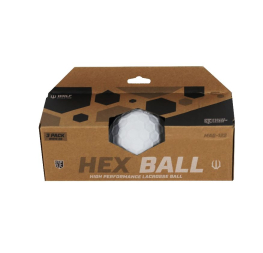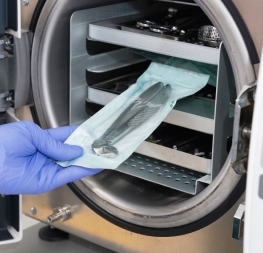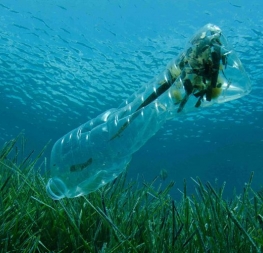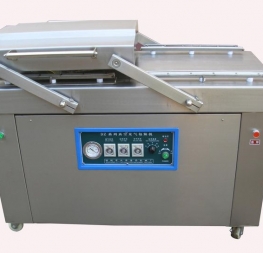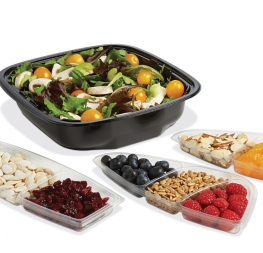Over-Packaging describes a product that is wrapped in multiple layers of materials, that is either unnecessary or unwanted by the consumer. An example of this is wrapping a small item in plastic, surrounding it with an air cushion, placing it in a box, and then placing that box into a larger box for distribution. This creates many negative effects for the company, consumer, and environment, yet it continues to happen on a regular basis. With the boom of E-commerce in the 21st century, the amount of packaging used for the transport of goods has dramatically increased, causing a negative effect on the environment. Amazon is found to be most guilty among online merchants for supplying more box than necessary for a product. The food industry also contributes negatively to the environment, with the increase of packaging in fruits and other fresh produces. An example is a dozen apples encased in a plastic clamshell. While there are benefits to this, such as keeping food fresh for longer periods of time, the negative effects on the environment outweigh the benefits by far. However, even with the growing pressure placed upon companies to create packages that attract customers to their product vs. other competitors, there are solutions to combat the large amount of materials used.
Whether talking about the amount of corrugated material used for distribution, or the amount of polyethylene used for packaging in the food industry, the common theme exists: It has to be reduced. The main goal of packaging is to protect the product. However, the amount of corrugated material used in distribution is often times more than necessary. With a recent interview from a UPS delivery driver, he stated “On a normal day over half of my truck is Amazon boxes, and a large number of customers ask, ‘Why is this box so big for what I ordered?’” For a company as large as Amazon, the number of angry customers created by over-packaging is far greater than you would expect. One might think using more material than necessary only affects the environment and company. However, there are also many negative effects for the consumer. For example, a customer receives food once a month from a diet subscription company composed of six individual boxes. They are placed in a box twice as large, which leads to the consumer having to drive to the post office several miles away to pick it up, because it is too large to deliver. While the product needs to be placed in a box that holds them all together, the overly large size of the box has led to a downhill spiral of events. The customer is no longer satisfied with Amazon, or the company that is selling the food, simply due to the inconvenience of having to drive to the post office. This leads to loss of revenue and unsatisfactory customer reviews. Another example is merchandise shipped to areas such as the Caribbean, where shipping cost is calculated by volume of the box. One can only expect a consumer to be extremely angry, knowing shipping cost for a small item is so pricey due to the large size of the box that holds it. While one unsatisfied customer might not make an impact, thousands of unsatisfied customers can potentially drive a business underground.
Companies are always looking for better ways to improve and cut costs. By reducing the size of a package, even by 2 square inches, can equal hundreds of thousands of dollars saved over time. Amazon ships approximately 608 million packages annually. This is a combination of cardboard boxes and padded envelopes. On the conservative side, even 500 million cardboard boxes shipped annually is an extraordinary amount 0f corrugated material. On a scale this large, reducing the overall size of a box can result in millions of dollars of savings. For example, 5,000,000 boxes are used each year for shipping a specific product. If the company cuts 5 cents off the overall price for the material, by reducing the box size by 2 square inches, this results in a $250,000 cost deduction. Over 4 years, a change this minor results in savings equal to one million dollars. Not only does reducing the size of a box reduce material cost, it also reduces shipping cost. Amazon is simply an online merchant, and relies on the services of shipping companies such as FedEx, UPS, and USPS to deliver products. In most cases, shipping costs are calculated by weight, size, and location. Therefore, by reducing the size of a box, it also reduces costs associated with shipping. Another factor to consider is the space on a truck that is increased by decreasing package size.
While angry customers and loss of revenue are negative effects associated with over-packaging, the ultimate consequence affects something we often take for granted: the environment. Conserving the environment is the responsibility of everyone on Earth due to the simple fact that once it perishes, it cannot be re-established. While over-packaging is not the only thing contributing to the increasing amount of greenhouse gas emissions, it is a fair contributor. The environment has faced many consequences, not only from the large amount of corrugated materials used in distribution, but also the large amount of polyethylene used in the modern society for food packaging. There is an abundance of consequences that come with something as simple as encasing a dozen apples in a plastic clamshell.
After packaging is used it gets thrown away. Often times it is in a trash can at home, but in many cases, it is on the ground in parks or other outdoor areas. All of the natural resources used to create a product simply go to waste and are no longer usable. Unfortunately, many times waste products end up in rivers, streams, and oceans. This causes many problems for Earth’s valuable resources, as well as plants and animals. Marine life often mistakes waste for food, and this can result in the destruction of an eco-system. Not only are products such as clamshells for apples using Earth’s natural resources like oil, the emissions created in the manufacturing process produce a large amount of harmful greenhouse gasses. Statistics show that 1.9 million tons of waste produces the same amount of greenhouse gas as 860,000 cars.
Cardboard is often thought to be environmental friendly because it is biodegradable and recyclable. While this is correct, the process of making cardboard is what damages the environment. Paper mills that create cardboard are some of the worst polluters in the world. Also, chlorine-based bleaches are used in the process of fabricating paper from wood, which results in toxic emissions to the air, water, and soil.
While packaging in the food industry offers benefits such as keeping food fresh, there are many consequences that follow. With the rise in demand for frozen food, snack foods, and other convenience foods, the demand for packaging is at an all-time high. This may be positive for the owners of food companies and grocery stores but with this come negative effects on the environment. The consumption of natural resources, environmental pollution from the production of plastics, and the waste created from packages are all negative effects on the environment.
A major problem with plastic bags is they are not biodegradable. This leads to landfills rapidly filling as well as waterways. While many people throw away plastic bags, there are great deals of people that simply litter and allow these bags to float off into the wind. With over approximately 500 million bags used annually, this can lead to a catastrophic problem. An estimated 300 million plastic bags end up in the Atlantic Ocean every year as a result of people littering. This large amount of pollution can have a very large effect on ecosystems. If one species begins to die, it affects the animals in the food chain above and below it, causing a snowball effect. The effects can be just as detrimental on land as they are in water. Plastic bags can take hundreds of years to breakdown, and even once they do breakdown, they still leave behind unusable land.
Whether talking about the amount of corrugated material used in distribution or the amount of plastics used in the food industry, there are solutions to combat these issues. Recycling is the first and most obvious solution to reduce the amount of pollution on Earth. There have been many processes developed to create new corrugated materials from recycled cardboard. This is far better for the environment than simply getting rid of these materials. Another way to reduce the amount of corrugated materials used for distribution is to reduce the size of boxes used. Not only does it reduce the amount of waste, it also reduces the amount of emissions created in the manufacturing process. It is often times the responsibility of a packaging engineer to develop a package that will allow for safe transport, as well as minimal use of material.
There are many issues with waste and pollution in the food industry. A major topic is the amount of plastic used for fresh produce. The solution to this is to simply remove it. While the benefit of keeping food fresh longer is there, the damage being done to the environment is becoming more relevant. There is simply no reason to place a banana on a foam tray wrapped with plastic. In fact, many consumers will actually avoid these types of packaged foods. For items such as frozen foods, or convenience snacks, the plastics used would better comply with environmental standards if they were produced from recycled material.
Plastic bags used in grocery stores, as well as other shops must be reduced. Stores offering reusable cloth bags can most effectively achieve this. By reusing cloth bags, it reduces the amount of natural resources used for production, pollution caused by littering, and pollution from the manufacturing process.
There are many problems we face today as a society, and the effects of over-packaging can weigh heavy on us as a consumer, as well as a company, and most importantly, the environment. As one, we must fight to reduce the amount of harmful materials used in our everyday lives.
References
The Effects of Plastic Bags on The Environment. March 22,2013
https://www.environment.co.za/pollution/the-effects-of-plastic-bags-on-environment.html
Effects of Over-packaging. November 24, 2013
https://packagingwaste.weebly.com
How Environmentally Friendly is Corrugated Cardboard?
https://www.packnetltd.com/blog/how-environmentally-friendly-is-corrugated-cardboard/


